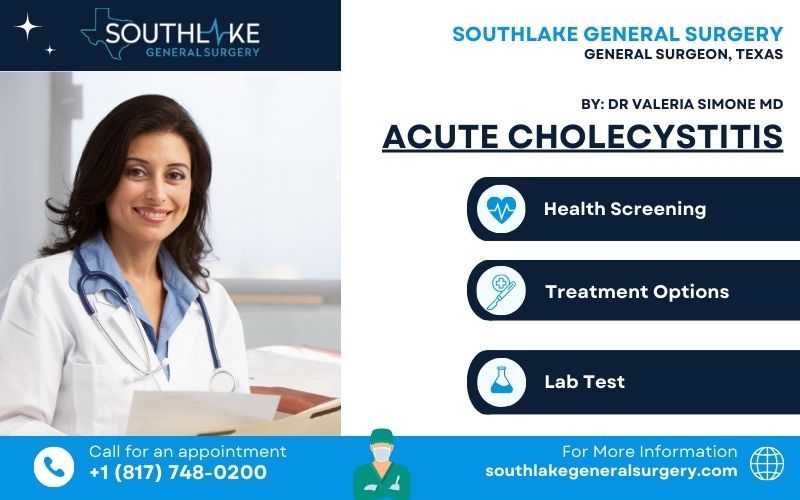Have you ever experienced a sudden, sharp pain in your upper abdomen that left you wondering what’s going on? You could be dealing with acute cholecystitis, an inflammation of the gallbladder that can lead to severe complications if left untreated.
In this blog post, we will delve into the symptoms, causes, treatment options, and prevention strategies for this often-overlooked condition.
Key Takeaways
- Acute cholecystitis is an inflammation of the gallbladder caused by obstruction of the cystic duct, typically due to gallstones.
- Diagnosis involves physical examination, laboratory tests, and imaging techniques such as ultrasound or HIDA scan.
- Treatment options include conservative management with antibiotics and pain relief or surgical intervention. The prognosis is good with early diagnosis and intervention.
Understanding Acute Cholecystitis
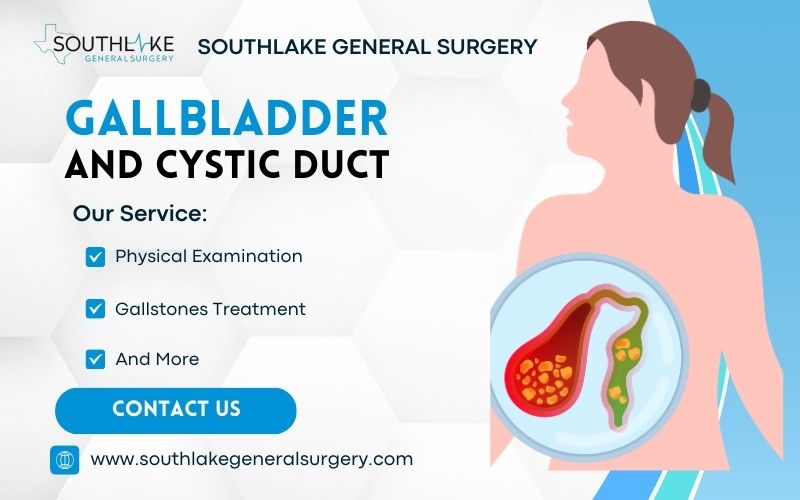
Acute cholecystitis is the inflammation of the gallbladder, a small organ located beneath the liver that stores bile, a digestive fluid secreted into the small intestine through bile ducts.
The condition usually arises due to an obstruction of the biliary tract or the cystic duct, often caused by gallstones. Prompt treatment of acute cholecystitis is imperative to prevent severe complications like necrosis, gangrene, or gas buildup in the gallbladder wall, which can eventually result in perforation.
Initial treatment for acute cholecystitis typically consists of antibiotics and pain relief, which can help alleviate gallbladder inflammation.
The gallstones causing the condition, such as uncomplicated acute cholecystitis, usually return to the gallbladder during initial treatment. However, more severe cases may require additional intervention to prevent complications.
Causes and Risk Factors
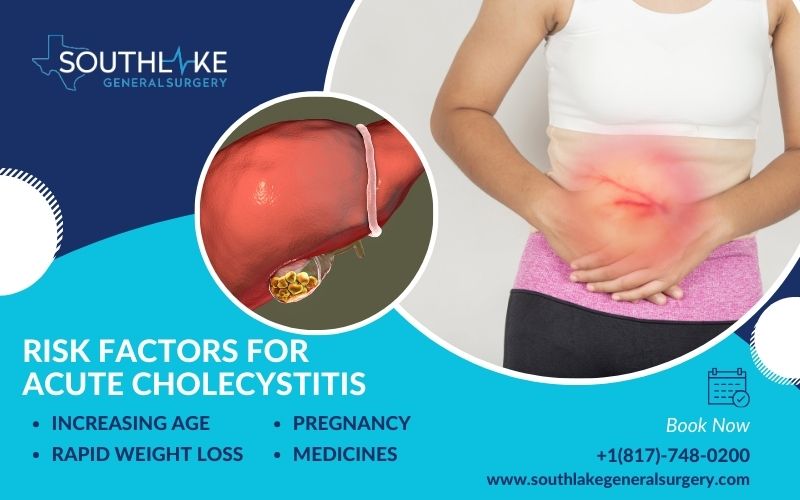
Gallstones, which are solidified particles composed of cholesterol or bilirubin, are the primary cause of an inflamed gallbladder, also known as acute cholecystitis.
These stones can obstruct the cystic duct, a short tube that conveys bile from the gallbladder to the common bile duct, leading to inflammation and potential infection of the gallbladder tissue.
Risk factors for acute cholecystitis include:
- Increasing age
- Female sex
- Certain ethnic groups
- Obesity or rapid weight loss
- Drugs
- Pregnancy
Additionally, gallstones can also increase your chances of developing this condition.
Acalculous cholecystitis, a less common form of acute cholecystitis, is caused by factors unrelated to gallstones, such as severe illness, bacterial infection, or injury that can damage the gallbladder.
Acute acalculous cholecystitis, a subtype of this condition, can be particularly severe and warrants prompt intervention.
Gallstones and Cystic Duct Obstruction
Gallstones and cystic duct obstruction are the most common causes of acute cholecystitis and chronic cholecystitis, with consequences ranging from acute inflammation to potential infection of the gallbladder.
When gallstones obstruct the cystic duct, the gallbladder becomes distended, impeding blood flow and lymphatic drainage, which in turn leads to mucosal ischemia and necrosis.
Biliary sludge, a combination of bile, cholesterol, and salt in the form of small crystals, can also play a role in the development of acute cholecystitis.
Prompt diagnosis and treatment of gallstones and cystic duct obstruction are critical in preventing complications and relieving the severe abdominal pain that often accompanies biliary colic, a condition related to this issue.
Acalculous Cholecystitis
Acalculous cholecystitis is a rare and serious form of acute cholecystitis that can result from severe illness, infection, or injury damaging the gallbladder.
In contrast to acute calculous cholecystitis, which involves gallstones, acalculous cholecystitis occurs without the presence of gallstones. In some cases, it can lead to complications like gangrenous cholecystitis.
The incidence rate of acalculous cholecystitis has been estimated to be 0.12% of the total population. This is considered to be a relatively rare condition.
Acalculous cholecystitis can rapidly progress to life-threatening complications if left untreated, making early diagnosis and intervention vital.
Accurate diagnosis is critical, as the symptoms of this form of cholecystitis can closely resemble other gastrointestinal issues, making it challenging to identify.
Acute Acalculous Cholecystitis
Acute acalculous cholecystitis (AAC) is a severe form of gallbladder inflammation that occurs without the presence of gallstones, a distinct characteristic that separates it from its more common counterpart.
AAC often strikes when the body is under severe stress, such as during critical illness, severe trauma, or major surgery. This rare condition is particularly menacing due to its rapid progression and high mortality rate, making it a serious medical emergency.
Despite its rarity, AAC shouldn’t be underestimated as it can swiftly escalate to life-threatening complications such as gallbladder gangrene or perforation.
Early diagnosis and prompt intervention are crucial in managing AAC, and it’s important to be aware of its symptoms which can include severe abdominal pain, fever, and jaundice.
Remember, acute acalculous cholecystitis is a wolf in sheep’s clothing, appearing in the absence of gallstones, but capable of causing severe damage.
Symptoms and Presentation
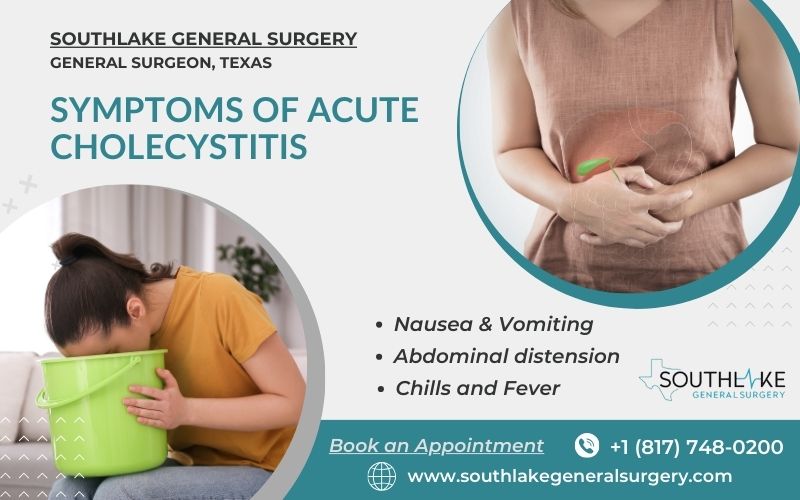
The most prevalent symptom of acute cholecystitis is upper abdominal pain, typically localized to the right upper quadrant and lasting for longer than six hours. This pain often commences several hours after a meal or in the evening.
However, be aware that cholecystitis symptoms can easily be confused with other conditions like peptic ulcer disease or pancreatitis.
Additional symptoms associated with cholecystitis include:
- Nausea
- Vomiting
- Shortness of breath upon inhalation (due to pain)
- Muscular rigidity on the right side of the abdomen
- Abdominal distension
- Chills
- Fever
If you experience any of these symptoms, seek medical attention promptly for an accurate diagnosis and appropriate treatment.
Diagnosing Acute Cholecystitis
To diagnose acute cholecystitis, healthcare providers employ a combination of physical examination, laboratory tests, and imaging techniques. Imaging tests, such as X-rays, CT scans, or MRI scans, may be conducted in a hospital setting.
Abdominal ultrasound and hepatobiliary scintigraphy (HIDA scan) are the primary imaging techniques used for diagnosing cholecystitis. These two techniques are often favored over other available options.
In addition to imaging and blood tests, a simple physical examination called Murphy’s sign may be performed by a healthcare provider. During this test, the provider:
- Presses their hand on the patient’s abdomen, just below the rib cage.
- Ask the patient to breathe deeply.
- If the patient experiences sudden pain as their gallbladder reaches the doctor’s hand, it may indicate cholecystitis.
A HIDA scan, which monitors the production and passage of bile from the liver to the small intestine, can also help detect blockages.
Treatment Options
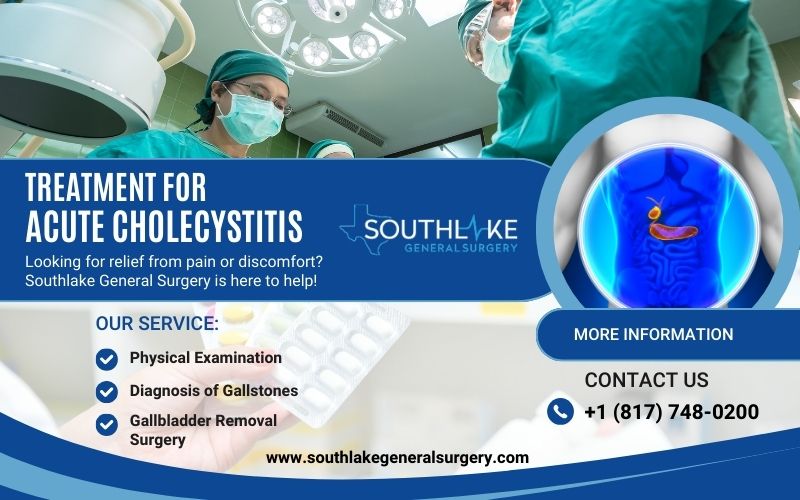
Treatment options for acute cholecystitis include conservative management with antibiotics and pain relief, as well as surgical intervention, such as laparoscopic cholecystectomy or percutaneous cholecystostomy.
The choice of treatment depends on the severity of the condition, the patient’s overall health, and the presence of any complications.
Conservative Management
Conservative management of acute cholecystitis involves antibiotics, pain relief, and monitoring. Antibiotics are employed to minimize the likelihood of infection and assist in diminishing inflammation. Pain relief is necessary for alleviating the discomfort associated with acute cholecystitis.
Patients undergoing conservative management must be monitored for indications of infection, inflammation, and any potential complications that may occur.
In some cases, conservative management may be sufficient to resolve acute cholecystitis without the need for surgery.
Surgical Intervention
For many patients, surgical intervention, such as laparoscopic cholecystectomy, is the preferred treatment for acute cholecystitis. This minimally invasive procedure involves:
- The gallbladder is removed by a series of small incisions in the abdomen.
- Typically, you can expect a shorter recovery time.
- In comparison to open surgery, less postoperative pain is experienced.
In some cases, particularly for high-risk patients or those with complications such as gallbladder perforation, alternative surgical options may be considered.
These include open surgery or percutaneous cholecystostomy, a procedure in which a small tube is inserted through the abdominal wall into the gallbladder to drain bile and other fluids, thereby relieving pressure and pain.
Complications and Prognosis
Untreated or inadequately treated acute cholecystitis can lead to life-threatening complications, such as perforation, sepsis, and bile duct injury tissue death.
Other complications may include cholestasis, gallstone, acute pancreatitis, and cholecystoenteric fistula. Emphysematous cholecystitis, a rare complication characterized by the presence of gas in the gallbladder wall, is observed in approximately 1% of cases.
The prognosis for acute cholecystitis is generally good with appropriate treatment. Most patients experience complete remission within 1-4 days, though 25%-30% of patients either develop complications or require emergency surgery.
Minimizing the risk of serious complications and improving patient outcomes requires early diagnosis and intervention.
Prevention Strategies
Prevention strategies for acute cholecystitis focus on reducing the risk of gallstones through a healthy diet, weight management, and avoiding rapid weight loss.
Maintaining a healthy weight and following a low-fat diet can help decrease the risk of gallstones, which can result in cholecystitis. Avoiding sudden weight loss is also beneficial in reducing the risk of developing cholecystitis, as it can contribute to gallstone formation.
In addition to lifestyle modifications, preventative medical therapy and cholecystectomy for symptomatic gallstone-related disease may be considered to decrease the risk of acute cholecystitis.
These preventive measures, combined with early diagnosis and intervention, can help minimize the impact of this potentially serious condition.
Summary
In conclusion, acute cholecystitis is an inflammation of the gallbladder that can result in severe complications if left untreated.
Understanding the symptoms, causes, and treatment options is crucial for early diagnosis and intervention. By adopting preventive strategies such as maintaining a healthy diet, managing weight, and avoiding rapid weight loss, individuals can reduce their risk of developing acute cholecystitis.
With appropriate treatment and lifestyle modifications, most patients can expect a favorable prognosis and a healthier future.
Note from Southlake General Surgery
We hope this article has provided you with a comprehensive understanding of acute cholecystitis. Our team at Southlake General Surgery is committed to providing the highest level of care to our patients.
We encourage anyone experiencing symptoms of acute cholecystitis to seek medical attention promptly. Early diagnosis and treatment are critical in managing this condition and preventing severe complications.
Don’t hesitate to get in touch with us for any health-related queries or concerns. Remember, your well-being is our ultimate mission.
Appointment
If you or a loved one are experiencing symptoms of acute cholecystitis, don’t hesitate to schedule an appointment with us at Southlake General Surgery.
Our team of experienced healthcare professionals is ready to provide comprehensive care and guide you through the diagnostic and treatment process.
Our unyielding commitment to your health and personal well-being is our foremost priority. Contact us today to book your appointment at +1 (817) 748-0200.
Frequently Asked Questions
What is the main cause of acute cholecystitis?
Acute cholecystitis is a serious illness caused by the blockage of the cystic duct by gallstones, resulting in bile accumulation and inflammation.
Does acute cholecystitis go away?
Although cholecystitis can sometimes go away on its own, it is likely that you will need surgery or antibiotic treatment to address the underlying cause. Therefore, it is not recommended to wait and hope that symptoms of cholecystitis will disappear.
What are the three stages of cholecystitis?
The three stages of cholecystitis are Grade 1, symptomatic cholelithiasis; Grade 2, acute cholecystitis; and Grade 3, gangrenous/necrotizing cholecystitis.
What is the prognosis for acute cholecystitis?
The prognosis for acute cholecystitis is generally good, but those with acalculous cholecystitis may have higher mortality rates of up to 50%-60%. Perforation and gangrene of the gallbladder are rare but can occur in delayed cases.
What are the main symptoms of acute cholecystitis?
The main symptoms of acute cholecystitis include upper abdominal pain, nausea, vomiting, shortness of breath upon inhalation, muscular rigidity on the right side of the abdomen, abdominal distension, chills, and fever.
Medically Reviewed By: Dr. Valeria Simone MD
Board-certified General Surgeon at Southlake General Surgery, Texas, USA.
Follow us on Facebook and YouTube.
References
- National Library of Medicine. Acute Cholecystitis. Mark W. Jones; Rafaella Genova; Maria C. O’Rourke. https://www.ncbi.nlm.nih.gov/books/NBK459171/
- National Library of Medicine. Biliary Obstruction. https://www.ncbi.nlm.nih.gov/books/NBK539698/
- Medline Plus. Acute cholecystitis. https://medlineplus.gov/ency/article/000264.htm

